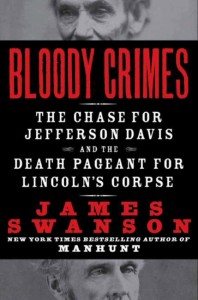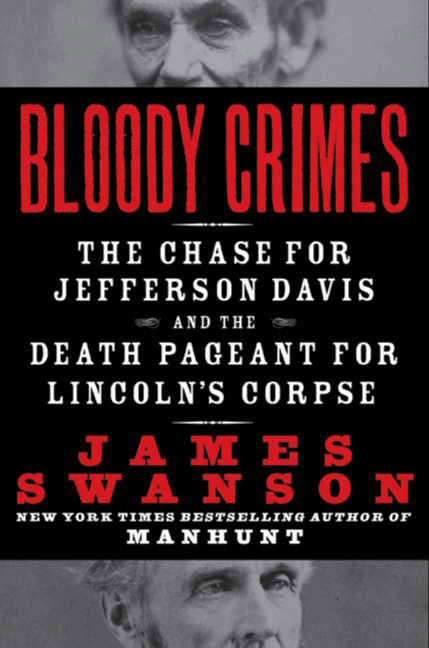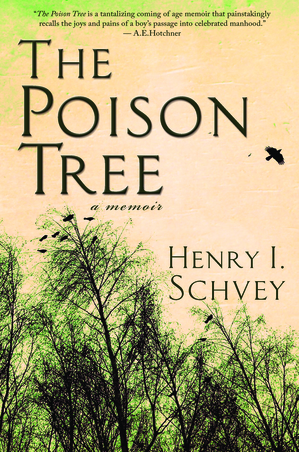Book Review: Bloody Crimes: The Chase for Jefferson Davis and the Death Pageant for Lincoln’s Corpse by James L. Swanson
Share the post "Book Review: Bloody Crimes: The Chase for Jefferson Davis and the Death Pageant for Lincoln’s Corpse by James L. Swanson"
by Julie Failla Earhart
 Even when I was a kid in high school, there was a lot of history to teach and to learn. A lot of areas were merely skimmed over, only teaching the highlights. I can’t imagine how history teachers manage today and what they must be forced to leave out or to gloss over.
Even when I was a kid in high school, there was a lot of history to teach and to learn. A lot of areas were merely skimmed over, only teaching the highlights. I can’t imagine how history teachers manage today and what they must be forced to leave out or to gloss over.
I’ve always been fascinated with American history, especially the Civil War Era. Maybe it’s because I grew up in the American South, where this history may be skewed a bit differently than in the rest of the country. To read an actual account, not tainted by loss, and written in story form rather than a dull scholarly tome, is refreshing and quite interesting.
One of my favorite writers of the Civil War Era is James L. Swanson. As author of Manhunt: The 12-Day Chase for Lincoln’s Killer, Swanson created a narrative account of the hunt for John Wilkes Booth as he tried to flee into the Deep South. He’s done it again with Bloody Crimes: The Chase for Jefferson Davis and the Death Pageant for Lincoln’s Corpse.
The book opens with Swanson explaining his choice of the title, Bloody Crimes. It’s part of a passage from Ezekiel (7:23) that John Brown highlighted and underlined while waiting to be hung for his attack on the U. S. Arsenal at Harper’s Ferry, Virginia, in 1859.
The first two chapters are a little slow as Swanson grounds the reader in the last days of the Civil War. The paragraphs alternate between Lincoln and Davis as Richmond falls and the Confederacy is doomed. Still, I was fascinated that Lincoln rode into Richmond mere days after it fell. Not as a gloating victor, but as a man truly concerned with those who had been left behind. I found it quite unsettling as Lincoln strode about the Confederate White House, even using Davis’s desk as his own. Davis, on the other hand, was headed further south, though determined to remain in Virginia.
By Chapter Four, the narrative takes off with Lincoln on his way to Ford’s Theater, and we all know what happened there. Swanson takes readers inside the Peterson Home and the bedroom where Lincoln died. I was fascinated with the autopsy, the weighing of Lincoln’s brain, the embalming of the corpse, and the pageantry that accompanied the death of the beloved President.
Davis almost takes a back seat, much like he does in today’s history books, while the nation mourns its sixteenth President. History buffs like myself know about the catafalque (an ornamental structure used in funerals for the lying in state of the body, which is still in use today when a prominent American lies in state in the Capital Rotunda) and the funeral train. What I didn’t know is that as the train traveled 1,600 miles from Washington, D. C. to Springfield, Illinois, it made several stops along the way at 13 major cities. When the train stopped, poor old Abe was hauled off the train, processed to a place where he would lie in state, the coffin opened for the mourners to view, then the pattern was reversed and he was hauled back onto the train.
Lincoln was gunned down on April 14. The funeral train didn’t leave Washington until April 21, and Lincoln was finally laid to rest on May 4, 1865. The embalmers did a remarkable job in keeping the corpse presentable during its trek across the country.
After Lincoln is entombed, the narrative switches back to Davis’ flight, capture, and how he lived out his final years. It broke my heart to read about the destruction of Davis’ library and the home known as Beauvoir where he spent his last years, being destroyed by 2005’s Hurricane Katrina.
In the end, nearly a million Americans viewed their martyr’s countenance and many more millions stood silently and in inclement weather, beside the rails as the train passed.
In the end, Jefferson Davis became a footnote in history but still haunts the Southern states.
In the end, Swanson uses fiction techniques to write a compelling story, using a vivid sty.
There is a beginning, middle, and end with plot points, narrative and foreshadowing. Even when the funeral train passages were getting a little old because basically the same thing happened in each city, Swanson’s writing style kept me engaged.



